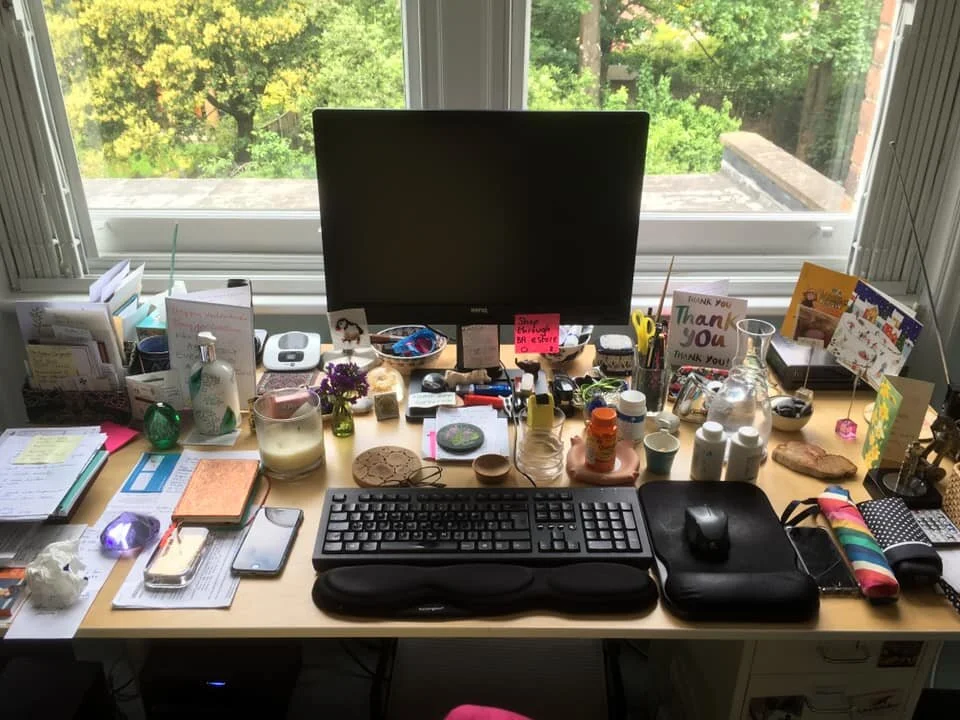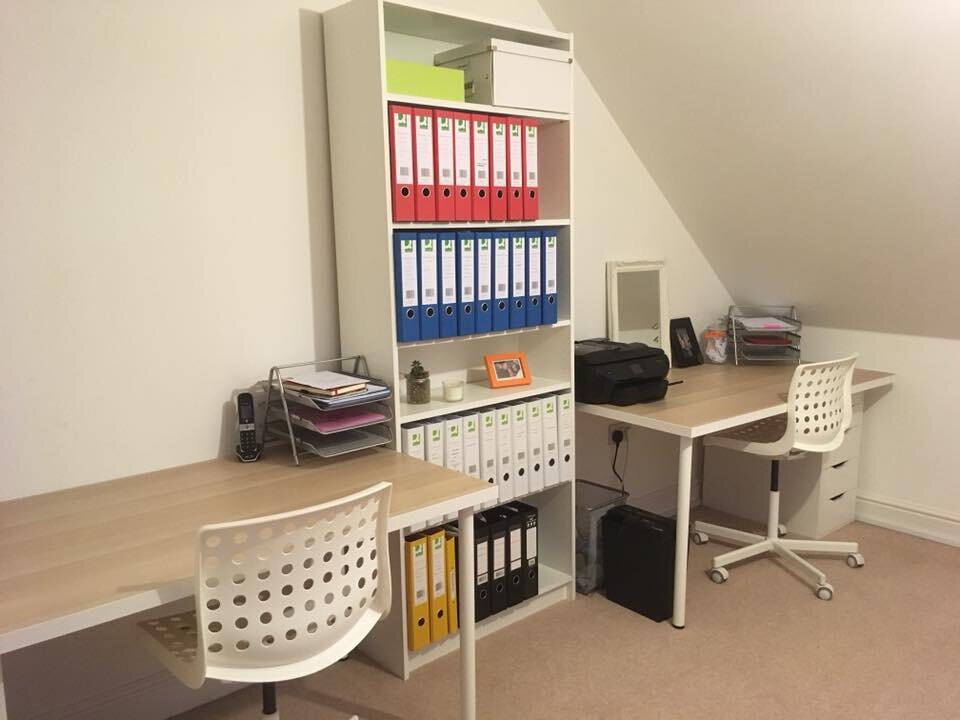Tidy Desk, Tidy Mind
If you’ve found yourself working from home due to Covid 19, to ensure you are working to the best of your ability, it’s time to take a fresh look at your workspace.
“Organising is what you do before you do something, so that when you do it, it is not all mixed up.”
Let’s start by standing back and looking at this space with fresh eyes. What are your eyes drawn towards? Do the contents spark a feeling of ease or discontent? Does the space inspire you to get down to deep work? Or does it appear uninviting and chaotic?
Some people work perfectly well in organised chaos, and if this is you it’s very unlikely you’d ever read this article. But if you’re still reading, there’s a high chance you’re hoping to do something about your workspace to increase your productivity and create a positive work environment. Visual clutter can be extremely distracting. So where do you start? I’m going to take you through the steps on how you can transform your workspace… And it should take no more than 2 hours of your time (depending on the volume of stuff you have stored there!).
Step One:
A transformative process always starts with a vision. So take a few moments to visualise your ideal working space. Is it uncluttered and clean, with only a few items that inspire you left in view? Is it completely minimalist, containing only the items you need to get your work done? Now for the emotional part: how do you want to feel when you’re working in this space: energised? Relaxed? Inspired? At peace? Being clear on how you’d like to feel in this space will offer some insight into what items need to stay to support you in achieving your ideal working environment.
Client JL - before
Client JL - after
Step Two:
Clear the space and subcategorise. Remove everything directly on the desk, in the drawers and from any pieces of furniture surrounding your central working space. Anything in your line of view needs to be considered during this process.
As you’re moving the items and completing your ‘desk decant’, make piles of similar items on the floor:
Books;
Magazines & leaflets;
Work papers & personal papers;
Stationery;
Electronics;
Food and drink;
And feel free to make up your own subcategories as you discover them, but be sure to keep like with like.
TIP: If you find anything that you want to discard as you’re sorting, get rid of it right there and then through recycling or throwing it in the rubbish. This will mean less sorting later on.
TIP: Once your space is clear, take the opportunity to give it a quick clean. As we all know, cleaning is much easier when your surfaces are uncluttered!
Client RR - before
Client RR - after
Step Three:
Choose what you want to keep. Go through each pile, one at a time following this order:
Books & magazines;
Work papers (personal papers should be stored elsewhere to revisit during out of work hours);
Stationery;
Electronics;
Food and drink;
The other categories you’ve created;
Sentimental items (inspirational quotes, thank you cards from colleagues, artwork from your children, memorabilia, photos etc.).
Pick up each item and ask yourself ‘Does this item contribute positively to my work?’ If it does, then keep it. If it doesn’t, either discard it or relocate it in your home. For the purpose of time conservation, it’s perfectly fine to put these items into a ‘relocate box’ temporarily and put them in their designated spaces in the home at a convenient time for you. If these items do not have an assigned home yet, then keep them in this box until you engage fully in the KonMari decluttering process. Having an organised work space in one thing, but having an organised home is the ultimate goal!
For stationery items, consider establishing a target number for each item and be realistic: do you really need 40 pens at hand when completing your work? Unless you’re an artist or calligraphy instructor, this may be a bit excessive!
For electronics, you should keep only those that support your work life in your work space. This isn’t the time to be running around the house trying to match up an appliance with a random loose cord so if you find anything that takes you away from the task at hand, pop it into the ‘relocate box’ (also know as ‘let’s tackle this later box’).
When you reach your final pile of sentimental items, select only those that will offer a meaningful source of inspiration while you’re working. The key to choosing items that serve this purpose is to consider the following: Does it motivate me to work or distract me from it? A photograph of your family can offer a source of comfort and motivation during your work tasks, after all, they’re probably one of the key reasons why we’re trying to work so hard! If the item motivates you, then it should remain in your work environment.
Client JA - before
Client JA - after
Step Four:
Once you have gone through your piles, you should now be left with only the items that contribute to your work life in a meaningful way. The final step is storing these items effectively, keeping like with like. Here are my top tips for storing work items:
Client RR - stationery drawer
Store work books together and stand them upright for easy access.
Store papers vertically using magazine holders; don’t be tempted to stack them. By storing them vertically, you make it easy to find what you’re looking for.
Store stationery in a drawer, and repurpose small boxes and their lids to create different compartments within your drawer. This will allow you to keep your items together in their categories, and prevent them from annoyingly jiggling around every time you open the drawer. If you don’t have a drawer, consider storing your stationery in a box and store it on a shelf or under your desk.
Electronics should be stored in a drawer. Keep cords contained by assigning a box to each one, and use an elastic band or bulldog clip to prevent the cord from unraveling.
Sentimental items that inspire you to work should be displayed front and centre. Whether they’re stored directly on your desk or stuck to a pinboard or on the wall, they should be stored in your eye line.
Client JL - repurposing boxes and lids for a stationery drawer
Client SR - before
Client SR - after
Step five:
Step back and reflect. Go back to your initial vision and ask yourself ‘Does my work space match my intended vision?’ How do I feel in this space now? Feel free to adapt things if and when you notice something that doesn’t work, particularly if it’s distracting you.
Work spaces are constantly evolving as new items inevitably come in so it’s important to create some boundaries to maintain your tidy space…
To prevent papers overcrowding your desk again, assign a time every week or every couple of days if you have a lot, to go through them. I like keeping a notepad in my magazine holder that lists all of the papers I have in there and therefore, the jobs that need to be done. Once I’ve done that job, I cross it off the list and examine all of the other paper tasks I’ve got left to do. It helps me work towards my mission of having no papers in my holder (which I’m sure will never happen!).
Follow the mantra ‘don’t put it down, put it away’. Now that every item in your work space has a home, there is no reason to leave it out. Operate a clear desk policy at the end of your work day and make sure every thing is put back in its designated place. It makes such a difference when you come back to your work if your environment has been reset the day before.
Client CA - before
Although the focus of this article has been on your desk space, if you have more time, and there are other cluttered spaces in your office to tackle, you can apply the same advice shared above.
Client CA - after
My client felt a change of unit colour was in order to enhance her wellbeing!
Client RR - before
‘It’s behind you!’… The area behind you also deserves some attention!
Client RR - after
No more terrifying shocks in store when my client leaves her desk!















